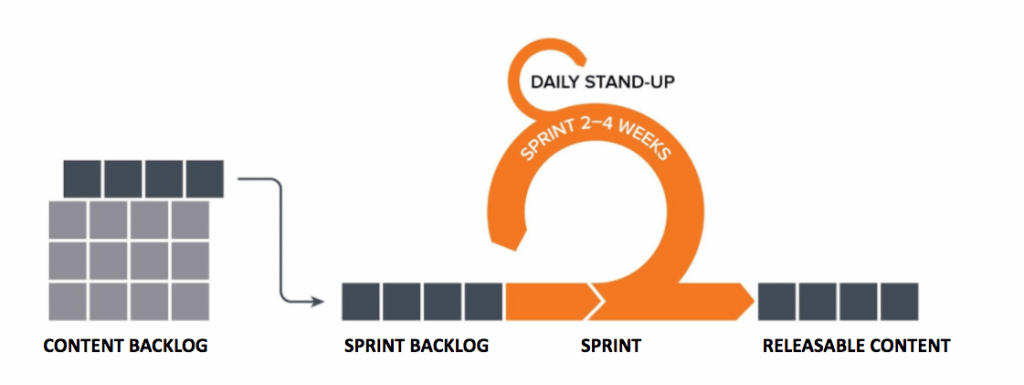
The Complete Agile Marketing Guide to Your Managing Your Backlog
Few things are more important to an effective Agile marketing team than a functioning marketing backlog, yet this particular practice is hard to get right.
Many teams struggle with prioritization, scope, and sizing the work in backlog.
These difficulties often lead to frustration and considerable lag time in updating the team’s to-do list.
The marketing backlog is the engine of a high-performing Agile marketing team, so it’s crucial to avoid these common pitfalls. We’re going to level set on backlog best practices and provide some guidance on making it into a well-oiled machine.
Quick Takeaways:
- A marketing backlog is the prioritized list of upcoming tasks.
- No two items on the list have the same priority.
- The Marketing Owner has ultimate responsibility for clearing the backlog.
- Many times, you need to right-size your tasks. Make sure the smallest unit can be completed by two people in two days.
What is the Backlog?
First we need to get clarity on definition, because the word “backlog” sometimes carries baggage.
The marketing backlog is simply the team’s prioritized list of upcoming work. It’s NOT where extra work gets parked.
That modifier “prioritized” is crucial, because that’s what helps differentiate the backlog from any other non-Agile to-do list. Important, time-sensitive, valuable work lives at the top; work gets less important and less valuable as you move toward the bottom.
Whenever the team is ready to start on some new work, they turn to the backlog and select the top priority item that they’re qualified to complete.
That’s it. That’s all a backlog really is.
It’s the engine of a great Agile team, but it’s not rocket science. It can, however, be complicated, so let’s proceed to some other crucial components.
What Goes Into a Marketing Backlog?
The short answer to the question, “What should I include in my marketing backlog” is “Everything.”
Whenever we train marketers on using this Agile practice, most of them nod along when we say that everything needs to be prioritized and visualized in their backlog.
Then we add that we don’t just mean all your projects or campaigns or initiatives, we mean literally ALL YOUR TEAM’S WORK.
Strategic stuff plus the business as usual (BAU) bits that you have to do just to keep marketing going — all of that lives in the backlog together.
That may sound complicated, and oftentimes it is, but it’s the only way for a content marketer like myself to effectively decide whether it’s more important to finish your weekly blog post today or to tackle the copy for the new sales enablement piece.
Both those things have to be prioritized against one another to make that decision.
If you keep everyone’s “day jobs” out of the backlog and just expect them to get it done, several unfortunate things can happen:
- Because their BAU work isn’t visualized, marketers will overestimate the work they can accomplish, leading either to overtime and burnout or delays in delivery (or both).
- Strategic work items from the backlog won’t ever get done because BAU work takes up 100% (or more) of everyone’s time.
- Marketing leadership doesn’t get visibility into the amount of work the team is really doing; all they say are the handful of strategic initiatives from the backlog.
So avoid all those issues and prioritize the team’s projects against its everyday work.
How Big Should Work Items Be?
This, of course, begs the question, “How do I prioritize a major project that will take me months to finish against a blog post that will take a few hours?”
This sizing discrepancy trips up a lot of Agile marketing teams, but it doesn’t have to be a backlog deal breaker.

There are two ways to handle the sizing problem: estimate and split work items, or simply don’t worry about it.
Lots has already been written about how and why to estimate work, so if you’re unfamiliar with this practice jump over and check out these pieces:
- Agile Estimation Explained
- Different Levels of Estimation (Product Backlog vs. Sprint Backlog)
- Estimation Practices vs. the #NoEstimates Movement
Once you’re comfortable estimating, you can begin to split up larger work items into more comparable sized pieces that can be prioritized against one another.
This can, however, be a time-consuming exercise, and it’s one that has long been a source of controversy in the Agile community at large (see the third article linked above for an overview of this ongoing debate).
So your other option when it comes to right-sizing work items in your backlog is simply not worry about it.
Follow the general rule of thumb from the Agile software world and try to keep your work items to a size that allows two people to finish them in two days.
When combined with a commitment to ruthless prioritization (more on that later), this guideline can help alleviate much of the anxiety around right-sizing work items in a backlog.
How Much Work Goes in the Agile Marketing Backlog?
There is, of course, a limit to how much work you can effectively handle in a marketing backlog. So be sure to cut it off at a reasonable point.
You’ll typically want about a quarter’s worth of work in your backlog; six months would be the absolute maximum.
And while you should be visualizing your BAU work alongside strategic priorities, you don’t want to cram your backlog full of tiny tasks.
If you’re sizing work you may want to limit the long-term backlog to just 3’s and above. If you’re using our two people/two days rule, simple to-do’s won’t come into play.
But, of course, seemingly tiny things can end up taking up more than their fair share of time thanks to our friend context switching, so you’ll want to keep an eye on them.
Agile Marketing Backlogs in Kanban and Scrum
The way to ensure visibility into the task level without creating a backlog of thousands of tiny work items differs slightly depending on the framework you’re using.
A Scrum team will look at their marketing backlog during Sprint planning and choose a subset of its work to complete during the upcoming Sprint. This work forms their much smaller Sprint backlog.

Once they select a work item to join the Sprint, they break it down into smaller tasks if needed. Team members then volunteer for the tasks, and everything that’s on deck is out in the open. Any tiny BAU items that are too small to live in the marketing backlog are also incorporated during Sprint planning to ensure a reasonable commitment from the team.
Kanban teams, on the other hand, don’t conduct Sprint planning meetings.
Instead, they can do a couple of things to break down work items.
One is to have a recurring planning meeting where the team does a breakdown of upcoming work. Once tasked-out, that work then moves from the Backlog column to Ready.
It sounds a lot like a Sprint planning meeting, but instead of happening every two weeks, Kanban teams would have it triggered by a visual cue on the board.
For example we might decide that once our Ready column gets down to just five items, it’s time to have a planning meeting. Sometimes this might happen in just a few days, other times it might take a couple of weeks.
This is known as “just in time” (JIT) planning.
Either way, the Agile marketing team has regular, recurring opportunities to take work items from the marketing backlog and break them into tasks so that the full scope of their work is always visible.
Power of Ruthless Prioritization
Of course, all the planning in the world does us no good if every item in the plan carries equal weight.
Ruthless prioritization is crucial for a marketing backlog to do its job.
This means no two items in the backlog can have the same priority; there are no two number one items.
For marketing teams who serve multiple stakeholders, business units, or other teams, this can get tricky. The classic example is the Agile marketing creative team, who needs to produce images, copy, etc. for multiple other teams, each of whom believes their work is the most important thing in the entire world.
It then falls to a team lead, which we refer to as a Marketing Owner, to make the call on behalf of the Agile marketing team.

Who’s Responsible for the Agile Marketing Backlog?
The Marketing Owner (more about them here), is responsible for the team’s output. Whatever the Agile marketing team produces falls on the MO’s head. They do this by prioritizing the backlog.
As you can imagine, this is often a challenging job, particularly in teams who serve multiple groups.
But that’s why this role exists. We need someone who understands both the business needs and the team’s capacity so they can make daily decisions about what work gets done and when.
Note that I said BUSINESS needs, not who’s yelling loudest.
The MO knows what the Agile marketing team as a unit, marketing as a department, and the business as a whole are trying to achieve, and they put work that contributes to those objectives at the top of the backlog.
It’s worth mentioning explicitly that if you have an MO who’s also a project manager and they only prioritize their projects, the team is not responsible for this unfair behavior. They work on what’s prioritized in the backlog and shouldn’t have to worry about whether that’s actually the right work.
Any favoritism displayed by the MO falls on them, not the Agile marketing team.
Again, you don’t have to call them a Marketing Owner, but if you’re going to have a backlog it needs to have an owner. And ideally just one owner.
If you have multiple MOs you lose time in negotiation and it may be impossible to arrive at meaningful consensus. But if you must have more than one MO, make sure you have a tie-breaker (usually the next level up the org chart) ready to settle disagreements about priorities.
How Often to Refine Your Backlog
The final crucial note here is not to let your backlog get stale. It should constantly be evolving based on emerging information, data about past campaigns, reactions from your audience, etc.
The MO should always be refining the backlog, adding detail and specificity to items as they near the top. They go and have fact-finding meetings with stakeholders to flesh out projects the team will soon work on, and they remove items that are no longer strategically relevant.
As we discussed earlier, the team will be pulling work items out regularly, so the MO needs to ensure they always have a steady supply of clearly defined things to work on next. The exact speed at which this needs to happen will depend on the length of a Sprint for Scrum teams, and how quickly Kanban teams process their Ready column.
A Backlog by Any Other Name…
Call it a backlog, call it a queue, call it your magical Agile to-do’s, just don’t let your backlog become stagnant.
Ruthlessly prioritize it and fill it with all the work your team is responsible for, and the backlog will propel you down the path to high performance.






